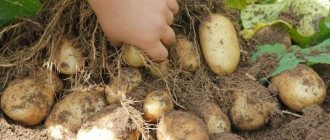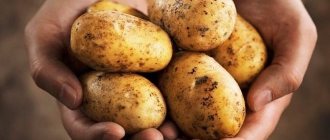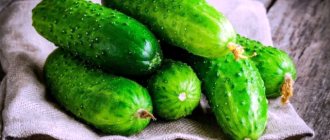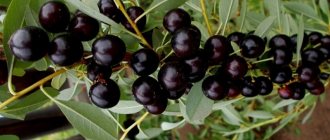Siberia and the Altai Territory are quite favorable regions for growing potatoes. Therefore, breeders have developed many different varieties. But we must not forget that in some regions it is warmer, and in others it is colder. Today we will look at varieties that are suitable for different climates. These will be the most productive and the earliest, also resistant to various diseases, and you can choose which one is suitable for your garden.
The most important thing, in my opinion, is that many will be interested in learning about potatoes that are resistant to the Colorado potato beetle. After all, many summer residents are interested in this. Of course, it won’t be possible to avoid it altogether, but breeders have long come up with the idea of making the beetle land on leaves less often.
In previous articles, we have already looked at the seeds of tomatoes, cucumbers, and eggplants that are resistant to various diseases and grown in cold regions. But you must admit that potatoes are also not an unimportant product that we eat. And, if a gardener is interested in any variety, then he needs to get a very good harvest.
Mr. Summer Resident advises: criteria for choosing potatoes for Siberia
Thanks to the efforts of breeders, each corner of our country has managed to develop its own varieties of vegetables, which allow us to harvest an excellent harvest even in conditions of not the best summer. No matter how excellent the characteristics, if the variety is not zoned for cultivation in the Siberian regions, then it is unlikely to be harvested.
For harsh climatic conditions, experts recommend choosing potatoes with early and mid-early ripening periods, because:
- Firstly, early ripening will allow you to avoid many diseases that do not have time to fully manifest themselves on the bushes.
- Secondly, fast-ripening potatoes will ripen ideally in Siberia with its short summer.
Another important advantage of zoned potatoes is their high adaptability to weather conditions. Potato varieties for Siberia, as a rule, easily adapt to weather conditions and easily survive temperature changes.
Tips and reviews
When choosing a variety, make sure that the tubers have increased shelf life and resistance to mechanical damage.
Important! Under unstable climate conditions combined with long daylight hours of 16–18 hours, early, mid-early and mid-ripening varieties grow well in Siberia.
Farmers give recommendations for growing crops in Siberia :
Dmitry, Novosibirsk region : “I green potatoes in plastic bags. I make holes in advance, pour 15 kg each and hang them on a glassed-in loggia. One beam can accommodate several bags with a total weight of up to 80 kg.”
Kristina, Tomsk : “I buy potato seeds for Siberia of several varieties with different ripening periods and grow them at the same time. Unpredictable weather will never prevent you from harvesting a good harvest.”
Terms and rules for planting potatoes in Siberia
Due to specific weather conditions, gardeners start planting potatoes in Siberia 2-3 weeks later than, for example, gardeners in the central zone. The usual deadline is May 20-25. But before that you need to prepare the planting material. In early May, the tubers should be removed from the storage location, the damaged and rotten ones should be sorted, then the remaining ones should be placed in boxes and placed in a warm and well-lit place. After 3 weeks, the shoots will be strong enough and you can start planting.
Growing
Growing potatoes consists of the same stages as in other regions: choosing a place for planting, preparing the soil, preparing seed material, planting, care, harvesting.
To grow potatoes, a sunny, level place must be determined, without free-flowing drafts. It is best if cabbage, carrots or cucumbers grew on the site before it. It is not recommended to grow potatoes in the same place for several years.
The soil is prepared in the fall - fertilizers are applied during digging: manure, peat, humus or mineral fertilizers. In the spring, the soil is fertilized again, dug up and potato planting begins. In Siberian conditions, only sprouted tubers need to be planted. To do this, in the spring, at the end of March - beginning of April, the tubers are taken out of storage, the largest and healthiest are selected, and they begin to prepare them for planting. They are kept for two weeks in a bright, warm room (+18 degrees), laid out on a flat surface in one layer, turning over periodically. Then they are transferred to boxes covered with newspaper and kept until sowing in a well-lit, warm place (+15 degrees). Thus, by the beginning of May, the tubers will already have strong sprouts. The process of heating and sprouting potatoes usually lasts about a month.
It is best to plant several varieties at the same time: with different ripening periods and different taste characteristics - you never know which variety will give a good harvest this year.
There are several ways to plant potatoes:
- traditional - rows are made at a distance of 70 cm from each other, in a row the distance between tubers is 30 cm. When hilling, the root system of the plant is damaged.
- tape - alternation occurs: 2 rows at a distance of 30 cm, then two rows at a distance of 110 cm from each other. Very good reviews from gardeners.
- ridge - tubers are placed in formed ridges about 30 cm high at a distance of 30 cm from each other. The distance between rows with ridges is 70–90 cm. Suitable for areas of high humidity and areas with high groundwater. On dry soils, potatoes in ridges often die.
Potatoes are planted only in warm soil
Article on the topic: Potato variety “Lubimets” - description and photo
The basic rules for planting and caring for potatoes are simple:
- The planting depth of potatoes varies from 6 to 15 cm, depending on the type of soil and the size of the tubers.
- To obtain high yields, it is important to follow the planting pattern - 30*65 cm. With more frequent plantings, the plants interfere with each other and form tubers poorly.
- Fertilizers in the form of ash, onion or garlic peels are applied to the hole.
- To get rid of weeds, you need to loosen the soil twice: before the first shoots appear and when the plants rise 15 cm.
- Water potatoes at least three times during the entire growing period: immediately after emergence, at the beginning and at the end of flowering.
- Drying of the tops is a sign of potato ripeness. Two weeks before harvesting, the tops are mowed, thereby allowing the tubers to ripen and the skin to thicken.
Regions and subjects of Siberia
The regions of Siberia are presented in the table below:
| Region | Subjects |
| West Siberian |
|
| East Siberian |
|
Tulunsky early
Early Tulun potatoes are for table use. Early ripening. Red tubers. The eyes are small. The pulp is white. The corolla is red-violet. Productivity 30 - 48 t/ha. Marketability 94 - 96%. The weight of the commercial tuber is 120 - 150 g. The starch content is 13 - 16%.
Tanai potatoes are a mid-early variety, suitable for table use. Included in the State Register for the West Siberian (10) region. The plant is of an intermediate type, semi-erect. The leaf is large, intermediate, green to dark green. Edge waviness is medium to strong.
Northern potatoes are an early ripening variety for table use. Included in the State Register for the East Siberian (11) region. Plant of medium height, intermediate type, semi-erect. Medium sized leaf, green.
Sarma potatoes are a mid-early table variety. Included in the State Register for the East Siberian (11) region. The plant is of medium height, stem type, erect. The leaf is medium sized, open, green. The edge waviness is average.
TOP 10 early potato varieties for Siberia
Early potatoes are good because they often have time to ripen before the plantings are attacked by pests, bacteria and fungi. For such varieties, some gardeners use additional cover, such as straw and film. As soon as the shoots appear, the film can be removed. This usually happens in the first ten days of June.
| Name | Productivity (kg per hundred square meters) | Number of days from planting to maturity | Degree of resistance to characteristic diseases and pests | Brief characteristics of tubers and taste Growing regions |
| Antonina | 210-420 | 60-70 | Highly resistant to cancer, average susceptibility to nematodes, prone to late blight. | Oval-shaped tubers weighing from 100 to 150 g. The skin is yellow, the flesh is light, the taste is pleasant. It has high keeping quality. West Siberian. |
| Bullfinch | 180-350 | 45-55 | Resistant to canker, moderately resistant to late blight and prone to nematodes. | The tubers are light, round-oval with white pulp, weighing up to 90 g. The taste is very good. Potatoes adapt to dry summers. West Siberian. |
| Priekulsky | Up to 250 | 45-60 | Only not susceptible to cancer. Prone to late blight, scab, viruses, blackleg and rhizoctonia. But it manages to ripen before diseases appear. | The shape of the tubers is round-oval. Weight ranges from 90 to 110 g. The skin is beige, smooth. Potatoes do not darken after peeling. Keeping quality is good. East Siberian. |
| Zhukovsky | 400-452 | 60-65 | Resistant to rhizoctonia and scab. Often attacked by mole crickets and Colorado potato beetles. | The skin color is pinkish, the flesh is white. The shape of the tubers is round, and the weight ranges from 130 to 150 g. Potatoes adapt perfectly to any weather conditions. West Siberian. |
| Kamensky | 185-250 | 50-60 | Average resistance to late blight. Low resistance to nematode. | The shape of the tubers is oval, elongated. The skin is red. The color of the pulp is yellow. The average weight of tubers is 120 g. Potatoes do not darken after peeling and cutting. West Siberian. |
| Rosara | 200-300 | 65-70 | Average resistance to late blight and scab. | Tubers are oval, oblong. The skin color is red, the flesh is yellowish. All Siberia. |
| Baron | 110-370 | 60-70 | Does not suffer from cancer, is not prone to nematodes, but is very often affected by late blight and scab. | The shape of the tubers is oval, the skin color is yellow, the flesh is light yellow. The taste is good. It is unpretentious in cultivation and requires virtually no expenses from gardeners. West Siberian. |
| Varmas | 210-380 | 60-70 | Does not suffer from cancer, is moderately susceptible to viruses. Most often it suffers from scab, rhizoctonia and late blight. | The shape of the tubers is oval, the color of the pulp and skin is white. Tuber weight is from 90 to 120 g. Taste is average. Has good keeping quality. East Siberian. |
| Luck | Up to 300 | 50-60 | Practically not susceptible to any of the potato diseases. But in unfavorable weather it is prone to late blight, alternaria, and nematodes. | Very large tubers, the weight of which can reach 400 g. The skin is thin, yellowish. Cookability is average, taste is good. Siberia is not listed in the access regions for this variety in the State Register, but it is grown in all areas of the region. |
| Impala | Up to 360 | 70-80 | High resistance to cancer, viruses and nematodes, average resistance to scab and late blight, susceptibility to scab and rhizoctonia. | Oval fruits with yellow, smooth skin and light yellow flesh. The weight of the tuber ranges from 80 to 150 g. Siberia is not listed in the access regions for this variety in the State Register, but it is grown in all areas of the region. |
The potatoes listed above show excellent results throughout almost the entire territory of our country.
Frost and disease resistant varieties
For cultivation in Siberia, the resistance of vegetable crops to pests and plant diseases is of great importance. In Siberia, not the least place in the characteristics of potato subspecies is occupied by the frost resistance of the variety.
This is the most suitable potato variety for the western Siberian regions, although it is also successfully grown in the east. This is a Dutch variety with oval tubers and light skin, resistant to scab and late blight. Yields reach 2.0-2.5 kg per potato bush.
Article on the topic: Potato variety “Antonina” - description and photo
Freske, bred by Dutch selection, shows resistance to the main diseases of vegetables: nematode and late blight. It tolerates changeable climatic conditions well, which is why it is on the list of the best varieties for Siberia. Potato tubers have a smooth surface and yellow skin.
Prior is a universal variety from the same Dutch selection. Often up to 1.0-1.2 kg of potatoes are harvested from a bush.
The variety is resistant to nematodes, powdery mildew and late blight. The oval root vegetables have a slightly elongated shape and a cream-colored peel, strewn with small purple eyes.
One of the best potato varieties for Siberia in terms of resistance to harsh climates is Adretta. This species is able to withstand sudden changes in weather, is resistant to diseases and is slightly susceptible to damage by pests. For these characteristics, many summer residents fell in love with it, despite the low yield: only 170-200 kg per 1 sq. m. Its tubers grow weighing up to 100-140 g, with white skin and yellowish pulp.
Option for planting potatoes in Siberia
Most novice gardeners are mistaken in believing that the more potatoes you plant in the garden, the larger the harvest you will be able to harvest at the end of the season. In fact, as Nadezhda Martsenyuk, a member of the Irkutsk Agriculture Club, assures, the success of cultivation lies in the specifics of planting. A woman shared her method of growing potatoes with one popular publication. And it turned out to be very simple and effective.
First of all, as Nadezhda says, she refused to dig and fertilize. At the beginning of autumn, she sows the entire space between the rows with rye, which grows in this place until the beginning of May. Usually by this time the shoots reach 10 cm in length. They need to be mowed and piled in the same place. Potatoes are laid out in piles at a distance of 25 cm from each other and covered with last year’s soil. As a result, ridges about 20 cm high and up to 40 cm wide appear on the site.
This method has several significant advantages:
- Planting material is protected from the cold.
- A bed mulched with rye residues is saturated with useful substances.
- Virtually no weeds.
- Alternation of planting potatoes in rows and between rows is observed. Which is useful for renewing the soil.
How to get a high yield
You can get a high potato yield in Siberia in different ways.
Growing in a greenhouse
For cultivation in a greenhouse, tubers begin to be prepared in November. When sprouts appear, the potatoes are transferred to boxes with wet sawdust or peat, and taken to a heated greenhouse. When the time for planting comes, the tubers will have formed strong shoots and roots. The holes are dug according to a pattern of 70*25 cm, 8 cm deep. A layer of peat or humus must be placed on the bottom, tubers on top and all this is sprinkled with a layer of earth. There is no need to water the plantings, otherwise you will create an excess of moisture and the tubers will rot. When the shoots appear and the soil dries out, then you can water the potatoes for the first time. During the period of growth, flowering and formation of tubers, the humidity in the greenhouse should be at least 80–100 percent. The air temperature must be maintained around +23 degrees. During the period of mass formation of tubers, it should be slightly lowered to +19 degrees. The harvest in the greenhouse reaches 350 kg per hundred square meters, and it is not exposed to diseases or pest attacks. Ideal for growing potatoes.
A greenhouse is an ideal place for growing potatoes
Greenhouse
If your greenhouse is occupied by tomatoes, cucumbers or other crops, and there is absolutely no room in it for potatoes, creating a greenhouse will help you. Plant the potatoes in the beds, install the arcs, stretch the film, pressing it to the ground and the greenhouse is ready. The film retains heat well, but does not allow air to pass through. Therefore, in good weather it will need to be opened for ventilation, weeding, watering and fertilizing of plants. The greenhouse must be closed at night. Thanks to the created conditions, you will get the harvest ahead of schedule.
The greenhouse retains heat well
Raised beds
Since the soil in Siberia takes a very long time to warm up, you can use the method of growing potatoes in high beds. In the fall, they are formed about half a meter high with the help of hay, soil and manure. Potatoes can be planted in these beds two weeks earlier than in open ground. To speed up the heating of the soil, the following method is often used: pour plenty of hot water and cover with film. After the soil has warmed up, the tubers are placed in it. It is better to cover the plantings until the frost leaves.
Raised beds allow potatoes to be planted earlier
Chinese method
The essence of the Chinese method is as follows: in the fall you need to dig a trench 50 cm deep, make three holes in it 70 * 70 cm, about half a meter deep, at a distance of 25 cm from each other. Organic matter in the form of grass, leaves, food waste, hay is placed at the bottom of the pit, and ash is added (2-3 cups).
In the spring, when the soil warms up to +7 degrees, half a bucket of humus is poured into the bottom of each hole, three potatoes are laid and sprinkled with 10 cm of soil. The potatoes are prepared before planting: a transverse cut is made in the middle of the tuber, so that an intact jumper 1 cm wide remains in the center. The plantings look like a trench with mounds, which must be mulched with straw.
As the potatoes grow, you will need to periodically add soil and fertilize them with bird droppings diluted in water, in a ratio of 20:1, respectively. Water the trenches as the soil dries, during hot periods - at least once a week.
When the trench is completely filled with earth, you need to let the plant rise to a height of 30 cm, then bend it to the ground, dig it in and tear off the lower leaves. As they grow, the bushes continue to be sprinkled with soil and sprayed, and the flowers are removed.
When planting potatoes at the end of April, in July you can harvest the first harvest: up to 16 tubers weighing 1.7 kg from one mound. By autumn, the yield increases to 24 kg per planted tuber.
| Advantages | Flaws |
| High yield, suitable for any soil, does not require hilling. | Requires a large amount of fertilizer, weeding is required, needs frequent watering, and takes up a lot of space. |
Any variety of potato suitable for your soil type and climate conditions is suitable for growing. According to reviews from gardeners, varieties such as Karatop, Lyubava, Rosara, and Scarlet have performed well.
Growing potatoes using the Chinese method video
Under the straw
Recently, the method of growing potatoes under straw has been widely advertised. There are two planting options: potatoes are buried in the ground or laid on the surface of the ground, and covered with a 20 cm layer of straw or hay on top. It is believed that this method is suitable for lazy people, as it does not require special care.
Germination dates for plantings in Siberia: are there any differences from other regions?
In fact, the timing of potato growth in Siberia is practically no different from this period in more favorable regions, if the correct preparatory work has been carried out in advance. Due to the short summer in Siberia, tubers must be planted in the ground as prepared as possible. Gardeners not only germinate potatoes, but also treat them with growth stimulants.
Another factor on which germination time depends is soil temperature. If it is consistently warmed up to +10 °C, then the potatoes will germinate faster. Gardeners sometimes cover a small area of plantings with film to prevent them from being damaged by frost.
In Siberia, sometimes it happens that time is running out, the shoots are about to grow to 2 cm, and the earth has not yet warmed up enough. In such a situation, you can make the hole not too deep - 5, or even 3 cm. The lack of soil can be compensated for during the first hilling.
Harvest and storage
Early varieties ripen in the first half of August, as evidenced by lodging of the tops . If the area is infected with late blight, the green foliage is sprayed with a solution of copper sulfate, and after a week they begin to dig up the tubers.
How and when to collect
Harvesting begins when 90% of the plants reach physiological maturity , the air temperature is not lower than +5°C, the soil at the depth of the tubers is not lower than +10°C.
Important! The tops are removed 4–6 days before digging vegetables. This technique prevents damage to tubers by late blight.
The dug up crop is laid out on film and dried in the sun . Before storing in storage, the tubers are stored for 10–12 days in a cool room until completely dry and cooled.
Fitness on trampolines: benefits and harms. Jumping on a trampoline - benefits and harm
Seed potatoes are washed, dried and left to grow for 3-4 days in a bright room. Solanine formed in the peel will protect vegetables from diseases.
Storage and keeping quality
2-3 weeks before planting the harvest, the room cleared of debris is whitewashed with lime with the addition of copper sulfate.
During storage, potatoes go through 3 phases : ripening, dormancy and awakening. The room temperature is kept no higher than +2...+3°C, humidity - 80–90%. When the temperature rises to +4°C, the eyes will begin to germinate prematurely.
All varieties recommended for cultivation in Siberia are stored almost until spring : shelf life reaches 89–95%.
Advice from experienced gardeners from Siberia
If you have the opportunity to visit your summer cottage every day or the garden is part of the household plot, then you can try to collect two harvests per season.
In mid-May, you need to choose a variety that can ripen in 45-50 days. It turns out that the first potatoes can be dug up already in the first ten days of July. Immediately after this, potatoes are planted in the garden with a ripening period of about 60 days. The tables above show all the varietal characteristics; you can choose any one that suits you.
In mid-September, begin harvesting the second crop. But since there is a lot of precipitation in Siberia at the end of summer, there is a high risk of developing late blight. Therefore, it is necessary to carry out preventive treatment of plantings, for example, with HOM.
But you should still remember that a second landing is always a risk. How justified he is will become clear only at the end of the season. It may be better not to take risks, but to choose a high-yielding variety. Then the need for double collection, and, consequently, double digging work, will disappear.
Other varieties
Siberian breeders are working hard to develop new varieties of potatoes that are best suited for cultivation in the West Siberian and East Siberian regions. Every year the State Register is replenished with new varieties.
Sarovsky:
- Siberian Research Institute, 2014;
- early (60–70 days);
- harvest volume - 245 c/ha, 5–9 tubers per nest;
- root vegetables: weight - 95-145 g, red skin, yellow flesh, starchy content - 14-18%;
- excellent taste characteristics, boils well, especially in puree;
- perfectly stored (96%);
- does not suffer from scab, nematode, rhizoctonia, blackleg, ring rot and viruses.
Sotochka:
- Siberian Research Institute, 2013;
- mid-season;
- harvest size - 180–340 c/ha, maximum - 465 c/ha;
- potatoes weighing 105–180 g, with reddish skin and yellow flesh, starchy content - up to 20%;
- excellent taste, universal use;
- marketability - 95%, shelf life - 92%;
- resistance to cancer, relative resistance to late blight, sensitivity to nematode.
Triumph:
- agro, 2021;
- early ripening (55–60 days);
- yield - 400 c/ha;
- large root vegetables (90-200 g), yellow skin, creamy flesh, presence of starch - 12-14%;
- wonderful taste, slightly overcooked, used in various dishes (mashed potatoes, fries, etc.);
- produces crops on all types of soil;
- lies for a long time, maintaining its presentation by 96%;
- immunity against nematodes, cancer, scab, late blight and viruses.
Epic of Siberia:
- Siberian Research Institute, 2021;
- mid-season, highly productive variety;
- light-colored potatoes;
- easily tolerates drought;
- excellent taste, universal use in cooking.
Jubilee:
- Siberian Research Institute;
- early ripening (70–80 days);
- productive (165–360 c/ha);
- potatoes: large (90–200 g), round, thick red skin, creamy inside, contains 14–15% starch;
- very tasty, a little soft, universal use;
- well preserved (88%);
- adapts to different weather conditions;
- does not suffer from nematodes, cancer and mosaic.
How to choose the right variety
Hundreds of old and new potato varieties are cultivated in Russia. But not all are suitable for the Siberian climate. Nevertheless, many gardeners, even in this risky farming zone, successfully grow potatoes and receive abundant harvests every year. The key to their success is the correct selection of varieties. It is recommended to take varieties bred specifically for Siberia or zoned (tested) in this area.
When choosing seeds for sowing, you need to pay attention to the following characteristics:
- cold resistance;
- adaptability to sudden changes in weather;
- yield indicators;
- immunity to viruses and fungi;
- simple agricultural technology;
- with a short ripening period;
- retains good product characteristics for a long time.
Potato care
The first watering is carried out after the seedlings begin to germinate. It is recommended to perform the procedure in the evening, under each bush, pouring about 7 liters of water. During the dry season, potatoes are watered up to 5 times.
When the soil dries out a little, it needs to be loosened. The procedure will increase oxygen access to the roots, and therefore help the tubers germinate. In addition, weeding will destroy growing weeds, and you won’t have to pull them out manually later.
In Siberia, even in June there is still a high probability of frost, so the bushes need to be hilled[/alert. You can put mulch under them from mown grass, straw, sawdust, and last year's leaves.
For rapid growth of tops and tubers, organic and inorganic fertilizers are used. Feeding is carried out three times per season:
- the first time with urea, for rapid growth of green mass;
- the second feeding is applied in the form of ash and potassium sulfate during the budding period;
- Fertilize the third time with superphosphate during the flowering period to accelerate the growth of tubers.











